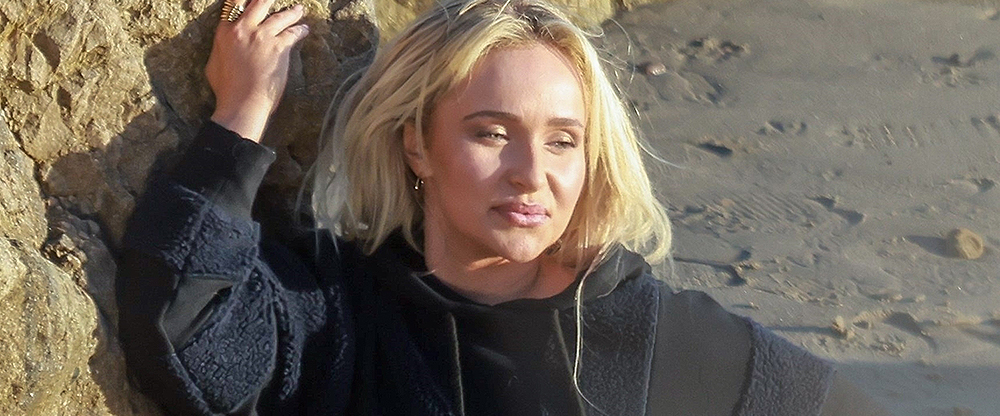
Back in January, Hayden was spotted shooting a ‘mysterious’ photo shoot for a magazine cover, and it has just been released that it was for Women’s Health March issue. She looks absolutely gorgeous. Photos and interview can be found below:
It’s the fourth consecutive day of rain in Los Angeles, and Hayden Panettiere, clad in a white sweatshirt and sweatpants, is lighting candles in the guest room of her apartment before cozying up underneath a blanket. The 33-year-old actor has owned this home since she was 16 years old— one of her first big purchases after moving from New York to L.A. and landing the role of Claire on the hit NBC series Heroes.
“This is the last place my family lived all together,” she says of her parents and younger brother, Jansen. Hayden moved multiple times over the past 15 years, including relocating to Tennessee to film the TV show Nashville. But she always held on to this place.
Recently, she’s been renovating it into her personal sanctuary since returning to L.A. after a four-year hiatus from acting. “I’ve completely redone it,” she beams, looking over her shoulder at two black-and-white prints she brought back from Montreal, where she shot Scream 6. She’s particularly fond of the lighting she installed—bulbs that change color to suit your mood. Now, they’re pink and yellow for warmth. “It feels like home,” she says.
There’s no missing the symbolism: This homecoming isn’t simply about a place. For Hayden, it’s a state of mind, a return to her roots—to herself—after years of struggling with postpartum depression and substance abuse and giving up custody of her daughter, Kaya, to her ex, retired pro boxer Wladimir Klitschko.
Hayden admits she’s nervous to do a cover tied to a movie release—it’s been awhile. But she says it’s important to her.
Plus, she has decades of experience to guide her.
Hayden started work as a child actor at 4 years old. She went from roles in popular daytime soap operas to Grammy nominee before she was 10. She starred opposite Denzel Washington in Remember the Titans at 11, and at 14, she trained to race a zebra in South Africa for the movie Racing Stripes. She’s done her own stunts (in heels) and learned to ice skate like a pro. She became a prime-time television staple for most of her teens and 20s, and while other celebrities her age were out partying, she was constantly working—and her star continued to rise.
Then, at age 22, she moved to Nashville and began drinking to cope with stress.
“I was being told how to be and how to live by so many people in my life,” she says. “I wanted certain decisions to be my own, and nobody could stop me. What I put in my body was like an act of defiance.”
Hayden maintained her professionalism on-set, and with no paparazzi following her, it was easy to hide her habit.
“Some people work out. I wish that was my coping mechanism,” Hayden says. “Alcohol might make you feel better in that moment, but it makes you feel so much worse the next day, and then you do it all over again.”
Her drinking ramped up in 2014 after giving birth to her daughter and dealing with crippling postpartum depression, which she describes as feelings of “extreme hopelessness” and “like all the walls are closing in.” (Postpartum depression occurs in about 6.5 to 20 percent of women after childbirth and can last for years.)
It was around this time that an old neck injury flared up, and Hayden began taking opioids. “I was in a lot of pain,” she says. “My tolerance got so high so fast that it became a problem.” She found herself in a vicious cycle, alternating between opioids and alcohol.
“I should have gone on antidepressants [to cope with the postpartum depression], but you have to find the right one that works for you,” she says. “They don’t mix well with alcohol, and I wasn’t ready to stop drinking.”
She entered rehab in the middle of production on Nashville’s fourth season in 2015. “I was the one who put myself in the first treatment center,” she says. “I was drowning.”
In treatment, she was told to change everything about her daily routine, from what she read to the people she surrounded herself with, yet returning to work made that advice basically impossible. In a cruel twist of fate, art was imitating life.
“They wrote my character as having postpartum depression,” says Hayden, whose daughter was going back and forth between Nashville and Ukraine (with her father) at the time. “They wrote that she abandoned her child and went to a different country. And it was very difficult to go on-set and to act out these feelings about these things that I was truly going through in my real life.”
Hayden eventually left the industry and the public eye to work on herself but returned to drinking to manage anxiety. That’s when her physical health caved. “I struggled with sleep deprivation,” she says. “Sleep is massive. It affects your motor skills, your ability to think, and your overall health.”
“My body was like, ‘enough,’” she continues. “I hit 30. My face was swollen. I had jaundice. My eyes were yellow. I had to go to a liver specialist. I was holding on to weight that wasn’t normally there. My hair was thin and coming out in clumps.”
She went back to treatment in 2021, enrolled in a 12-step program, and even went to trauma therapy.
“I did a lot of work on myself,” Hayden explains of this soul-searching period. “After eight months of intensive therapy, I felt like I had this blank canvas to work with.”
Now, without alcohol or opiates, her body is recovering, and she’s choosing which habits will fill that blank canvas. At night, she sips chamomile tea with milk and honey while soaking in vanilla-scented bubble baths. She’s finally sleeping again. She works out with trainer Eddie Pavese, whom she met while in treatment, and keeps a Peloton in her bedroom—though she admits she doesn’t have a rigid workout schedule in order to keep exercise from feeling too much like a chore.
Part of her recovery process has included reclaiming herself after childbirth too.
“My body still didn’t feel like it belonged to me,” Hayden says, explaining why she decided to get a breast reduction in November 2022. “I don’t think there’s anything wrong with somebody who wants to tweak something if it makes them feel more confident. That’s all I have to say about it. My confidence is back.”
Perhaps the biggest shift is how Hayden has learned to connect to herself emotionally and view her journey with compassion. “A big part of my therapy has been living in forgiveness,” she says. “A step in the 12-step program is making amends. If somebody wants to be a good person and to be the best version of themselves, they can choose to do that.”
Speaking of amends, her daughter, for now, doesn’t know about her mother’s struggles, but Hayden’s “looking forward to the day where I get to have these conversations with her,” she says. “I’m grateful that I’m equipped with the information and with the experience that I’ve had with postpartum depression.”
Hayden’s return to acting was inspired, in part, by the desire to go back to a feeling of “home,” in the well-being sense.
“In therapy, I kept wanting to go back to the beginning of the period of time where I was really happy and healthy,” she says of reprising her role as Kirby Reed in Scream 6. (Hayden has fond memories of filming Scream 4 in 2010 and says she’s still on a text thread with her costars from the movie.)
This time around, though, she and her character have something in common: They’re both survivors. “We saw Kirby get stabbed, but we never saw her die. We didn’t see her rescued either,” Hayden says of her character’s fate. “She has that human trauma, and it’s changed her. That’s something I can obviously relate to.”
Kirby is back, and so is Hayden. Her homecoming has been hard-earned—rebuilding from the inside out to become the strongest, healthiest version of herself. This is the Hayden of the future, the woman who creates her own environment and makes her own moves. The best part? She feels like she’s just now getting started.
A version of this story ran in the April 2023 issue of Women’s Health. The interview with Hayden took place in January.




































